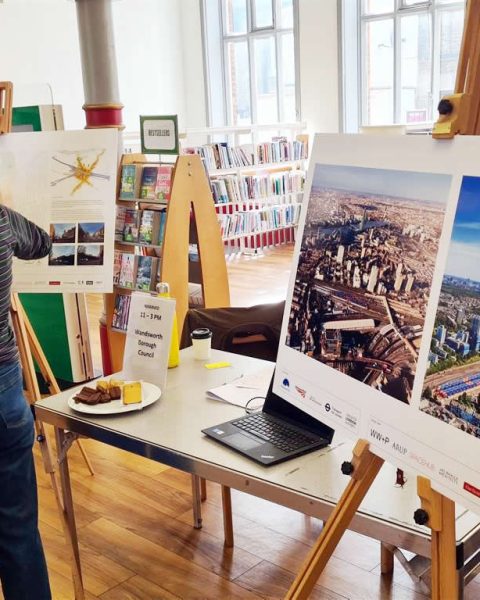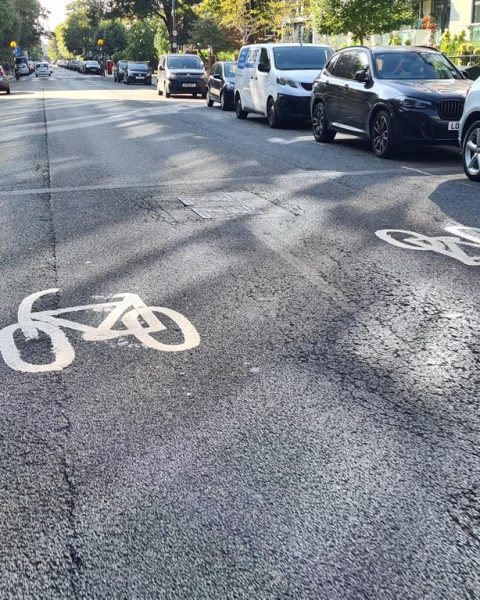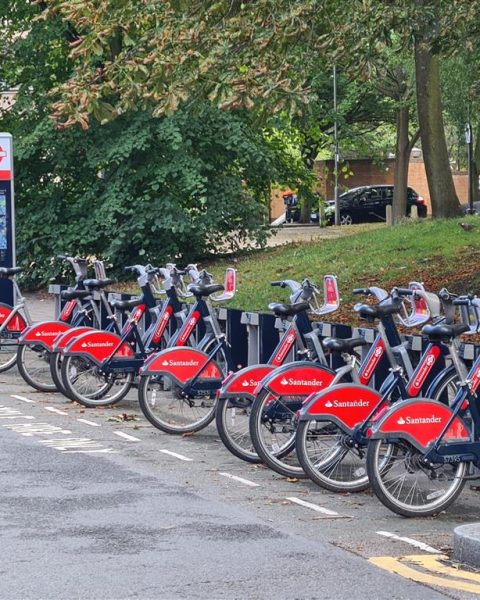The council’s exemplar streetscape plan has several welcome aspects. It should certainly make crossing the road at the main crossroads (St John’s Hill, Lavender Hill, Falcon Road, St John’s Road) much easier and safer – as long as sufficient time is given to the ‘green man’ phase and we don’t have to wait too long for the pedestrian phase. The plan to remove the railings and ‘sheep-pens’ at this crossroads will remove obstructions for pedestrians, enable the footway to be widened and make it safer for cycling. Removing the c entral railings along Lavender Hill to enable drivers to turn right into Falcon Lane will reduce journey times for those travelling north and should reduce motor traffic congestion at the crossroads. It will also make it easier for those on foot to cross Lavender Hill.
entral railings along Lavender Hill to enable drivers to turn right into Falcon Lane will reduce journey times for those travelling north and should reduce motor traffic congestion at the crossroads. It will also make it easier for those on foot to cross Lavender Hill.
The plan, however, does little to reduce the dominance of motor traffic. The Battersea noise maps shows how intrusive this is. Diverting traffic down Falcon Lane merely transfers the noise and congestion onto this narrow road past the entrance to two supermarkets. The Mayor’s Transport Strategy has the aim of reducing CO2 emissions by 60% from 1990 levels by 2025. It’s difficult to see how this target can realistically be achieved without reducing motor traffic volume and speed.
The council claims to wish to make Lavender Hill safer for cycling by means of cycle lanes on both sides. A glance at the the Department for Transport’s ‘Cycle Infrastructure Design’ (Local Transport Note 02/08, October 2008) will discover how far these diverge from published standards and guidelines for safe street design. Lavender Hill has, and will continue to have, a single yellow line which means drivers can stop to unload/load or just nip into a shop. This blocks precisely that part of the road where the Council plans for cyclists to go. Installing a cycling ‘facility’ which is of such questionable use is surely a waste of public money.
The DfT has a great deal of guidance for councils on designing streets for safety, not only for cyclists but also for pedestrians. For instance:
“Cycle lanes are not always suitable and may encourage cyclists to adopt inappropriate positioning if the lanes are poorly designed. Designers need to decide whether a cycle lane is going to help or not. If so, its alignment should ideally reflect guidance and training on safe techniques (Franklin, 2007)** for manoeuvres undertaken by cyclists….” (LTN 2/08, Cycle Infrastructure Design, DfT, October 2008, para 7.1.4)
And:
“On high streets with many side roads, bus stops, kerbside parking and accesses, there can be many cross-movements for cyclists to contend with. They may be little benefit in providing cycle lanes in situations like this (see Figure 7.1 [1]).” (LTN 2/08, DfT, October 2008, para 7.1.5 – figure 1 shows a situation very similar to Clapham Junction [1]).
Also:
“A cycle lane in the downhill direction can make conditions worse for cyclists. As a cyclist’s speed increases, the speed differential with motor traffic speeds reduces or disappears, and the cyclist needs to take up a more prominent position further from the nearside kerb. This helps ensure that drivers waiting to join from a side road can better see them and helps drivers behind to judge when it is safe to overtake. A single cycle lane of the recommended width going uphill is far preferable to sub-standard cycle lanes in both directions…” (LTN 2/08, DfT, October 2008, p35, para 7.1.6).
I would add it makes it easier for a pedestrian wanting to cross the road to see a cyclist in the running lane than close to the kerb. It also makes it easier for a cyclist to avoid the pedestrian who steps off the footway thinking the road is clear.
Alongside the exemplar ‘streetscape’ plan, the Council has worked with Network Rail to reopen the Brighton Yard entrance which gives access to the station over-bridge and lifts. This should reduce passenger congestion in the under-pass as just under one third of rail passengers approach the station from the Wandsworth direction. However, there will not be a crossing located here to enable those who need the lifts to get to them from the other side of the road. There will be covered cycle parking for the station in Brighton Yard, but there is no plan to facilitate the right turn into Brighton Yard from St John’s Hill so that cyclists can gain access to it from the Battersea direction, nor for the right turn out of it for those whose route is in the opposite direction. The footway on the station side from the existing crossing will not be widened as far up as this. On the contrary, a bus stop is planned, which, while good for access by bus passengers, will congest the footway even more.
The Council’s rationale for failing to provide for safe and convenient access into Brighton Yard is the lack of visibility for drivers coming from the Wandsworth direction over the rail bridge. As we know, the crossroads are in a valley formed by the Falcon Brook. Yet the ‘exemplar’ plan has no proposal to reduce motor traffic speed. Recent research on 20mph zones across London found that they resulted in a 42% reduction in traffic casualties (Grundy, et al, 2009). Reductions in both number and severity of deaths and injuries applied to all road users. Not surprisingly, the greatest beneficiaries were younger children. Perhaps more surprisingly, a considerable casualty reduction was also found in drivers.
An additional benefit of having safer roads is the reduction in noise and fear. For at least half a century we have gradually come to accept the domination of motor traffic on our streets, but as Living Streets (formerly the Pedestrians Association) say “It doesn’t have to be like this”. Rod King of the ’20’s Plenty’ campaign points out the difference between the ‘Go Ahead’ Councils and the ‘Can’t be Done’ Councils. Increasingly throughout the country the ‘Go Ahead’ are responding to demands for safer streets and are making all their streets 20mph. This includes major cities like Portsmouth and Oxford. Nine London Councils are currently planning it.
Reducing the volume and speed of motor traffic can transform our streets. By returning our streets to life we can contemplate reversing the increasingly sedentary lifestyle which is responsible for the obesity and lack of fitness in our population. Children can be freer to walk and cycle to schools, parks, visit friends. We will be able to let go of the belief that the only way to travel safely on roads is by car. Projects abound to encourage us to be more active. But what is the point of exhorting parents and children to walk or cycle to school, for example, if the streets are not made safe or convenient enough for them to do so?
The Department for Transport has recently issued new guidelines which aim to help Councils to adopt local authority-wide 20mph limits. Experience where an authority-wide 20mph speed limit has already been introduced has shown that it can be done without the need for speed bumps or other ‘calming’ devices. Drivers report they like the ‘default’ 20mph limit because it reduces their stress and saves fuel (Social Attitudes 2005) while not affecting the duration of their journey. With proof that it can save deaths and severe injuries, reduce fear of traffic, and make a town centre as well as local streets more attractive, what excuse can there be for not introducing a ‘default’ 20mph speed limit in our own borough, particularly in a motor traffic-dominated area like Clapham Junction?
[1] Franklin, J. 2007. ‘Cyclecraft’, 4th edition. London: The Stationery Office.
Read also our previous article on the Exemplar Scheme HERE.

Click on the picture to display bigger.

















Some good points. I particularly agree that the crossing should be moved up nearer the new entrance, the more people that use it the better (i’m not at all convinced by the councils statistic that 1/3 of people will use it).
I expect you are right about the cycle paths as well, and they are just ticking boxes, so as to look good on paper.
FYI there is a site on the council page where you can vote for your top improvements:-
http://www.wandsworth.gov.uk/stations
(sorry if this has already been posted, didnt see it anywhere)
I would be really surprised if at most times of the day traffic speeds at CJ attain anything like 20mph as it is.
I am not opposed to the new scheme in general, but thought it was all consulted on quite some time ago. It’s a good idea to get it right though. Unfortunately street furniture, planters, signs, paving etc etc are used as a sort of self continuing mechanism to spend taxpayers’ money and keep hordes of functionaries in jobs and pensions. Let’s not forget it was them, or their predecessors, or dreamt up what’s there at the moment.
It’s also a good idea to remember that lots of expensive bike lanes don’t get used, and pedestrians and cyclists use desire lines rather than what’s painted or railed at great expense on the surface in any event. If you want evidence of that look at eastbound cyclists on the pavements at Wandsworth High Street any day.
The discontinuance of revolting spitting of gum onto the pavements would be another remarkable improvement, but nobody likes to mention that one.
David Rosemont> I worked in Copenhagen, and I assure you that cycle lanes are used. They also implemented plenty in Paris for the past 5 years and if at the beginning pedestrians or cars were not paying much attention (thus maybe also cyclist not using them intensively) it has changed now.
Therefore there is no reason that London be the only city with cyclist refusing to use proper and adequate cycle lanes.
I regret that I have not been in Copenhagen for rather a long time (1962) but it’s pretty dead flat and a small place. Paris I know better and am frequently there. The bike rental scheme there is v popular-downhill. I personally would be rather hesitatntto cite Paris as an example of good traffic management.
In London there are still plenty of bike lanes around which are just put there for the sake of political correctness and are hardly used. At the same time I am TOTALLY against bikes being ridden on pavements which is frequently the case and dangerous- similarly the practice of bike riders ignoring traffic lights. Cycle lanes are OK where they are properly thought through as part of an integrated system. I have a feeling that bike lanes are like most traffic schemes and street improvements- one huge opportunity to spend public money. Example Wandsworth Council and the GLC were responsible for the previous apparatus in the streets at CJ (about 20 years ago) but now want to do it all again, and, wherever possible, and naturally, they will seek to get developers to pay for it. It’s not so long ago they took UP all the york stone, no doubt they will be putting new stone DOWN soon, having sold the last lot.
David Rosemont> I am not disputing the fact that Paris’ traffic might be a bit difficult. Although you have to consider that 10 years ago, both capitals across the channel wanted to reduce the number of vehicles. Options were:
– congestion charge
– make driving more difficult and encourage public transport and cycle.
London and Paris chose a different option.
One thing that London must certainly be pride of is the bus system. But having used a bike in London, I must say it is very scary to pass or be passed by a double deck bus on a big road where there is nothing for cyclists.
PS: Copenhagen is lovely. Was there 3 years ago. A bit cold in Winter though.
A well researched and well reasoned article or blog or whatever it is. I do agree that the proposed scheme continues to put motor vehicles first. From a cyclist’s perspective, and I’ve cycled over 100,000 miles in London, the points about cycle lanes are spot on. I tend to avoid cycling on this stretch of road, it is just too dangerous and unpleasant. From, I think, Cyril’s remark that “London be the only city with cyclist refusing to use proper and adequate cycle lanes” I can only think he hasn’t done a lot of cycling in London himself. If the lanes are “proper and adequate” why wouldn’t cyclists use them? There does seem to be a deep-set hostility to cycling in the council, and I think they are continuing to pay lip service to the idea by painting little strips of road green. There’s no real desire to make the roads safer for people turning pedals, not ignition keys. It used to be 17 times more dangerous to travel by bike than car. Apparently the new figure is 19 or 20 times. I understand that cycling is the only transport mode that is becoming more dangerous.
Ed Fawssett> Did I say that London WAS the only city with cyclist refusing to use proper and adequate cycle lanes? I rather said the opposite writing that THERE IS NO REASON… to say that (replying to a comment from David Rosemont).
I actually totally agree (and that is what I tried to express -sorry for the misunderstanding) that if cyclist do not use the lanes, it might be because they are inadequate.
And I also expressed that yes, I think travelling by bike in London is dangerous.
John Franklin is widely discredited, his “research” is cherry picked to agree with his agenda.
The lack of cycle lanes combined with narrow road lanes makes cycling even more unpleasant in these new street designs. It is now very unpleasant cycling up Falcon Lane as there is just no room for a car (let alone a truck) side by side, yet most cars will try and overtake before the junction even if there is a huge queue of cars. I have now taken to cycling on the right of the cars as this by far the safest place, even as they now undertake and are confused by where I am cycling. Try expecting children to do this!!!!!! Join the Blackfriars protest tomorrow for safer streets for all.
Juat goes to prove that one man’s exemplar is another’s nightmare. In point of fact the council and the regional council have wasted considerable sums on street improvements in this centre as well as in others. Years ago they ripped up first the stone paving and sold it to replace it with precast slabs and later block paving and brick planters (council designed) that have just been removed. I have seen it done twice but probably won’t be around to see the next time but there will very surely be a next time. It gives the bureaucrats something to do. To use the word “exemplar” in the case of the current tinkering is gilding a rather feeble lily. I now live in France but the councils here do just the same! My village was relandscaped a couple of years ago and a good amount is already breaking up. It’s a perpetual circle designed to keep the boys in work, and in their grossly inflated pensions!